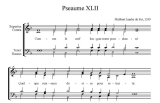Pierre Pidoux,
Le psautier huguenot du XVIe siècle,
volume 2: Les
documents(Basle, 1962)
Addenda & corrigenda
Pierre Pidoux, Le psautier huguenot du XVIe siècle, volume 2: Documents et bibliographie (Basle, 1962)
Psautier Huguenot, volume 1 - mélodies
Psautier Huguenot, volume 2 - documents
Psautier Huguenot (general info)
nota praevia: bibliographical material concerning published Psalters has been gathered by J.M. Noailly and is/will be published. (see several issues of the bulletin "Psaume"). In this field completeness is illusory, and a dynamic online-database is the appropriate instrument. E.g.: for publications in the area of Geneva, Neuchatel and Lausanne, J.F. Gilmont runs a wonderful database: GLN-16: https://ville-ge.ch/bge/gln/. The value of Pidoux's books lies in its mixture of bibliography and other texts ('Acta' of the Council of Geneva, Consistoire, letters, sermons, faits divers, personal diaries etc...). These texts 'document' the origin and spread of the Psalter, provide its context. Gradually I will add some pictures as well.
- also included in the addenda: corrections etc. by François Lesure and Marc Honneger (marked by FS and MH), published in Revue de Musicologie, Vol. 49, No. 127 (Dec., 1963), pp. 237-244). Corrections by Howard Slenk, who wrote his dissertation on the Huguenot Psalter in the Low Countries (Ohio, 1965) are referred to as HS.

-
Avant-propos
p. VII - Line 6: A copy of Octante-trois pseaumes de 1551 (GE51) has been
found and published since then. Description below sub 1551.
p. VIII-IX The reliability of story told in the Villemadon-letter, quoted in
extenso by Pidoux (popularity of Psalm-singing at court following the
offering of a presentation copy of the Trente Pseaulmes to Emperor
Charles V), is questionable. See Dick Wursten, 'Did Clément Marot really offer
his Trente Pseaulmes to the Emperor Charles V in January 1540?' Renaissance
Studies 21 March 2008,
https://doi.org/10.1111/j.1477-4658.2008.00489.x
p. XII - "Psalmes à 3 parties de Cottier" (mentionné dans le catalogue de Plantin parmi les ouvrages imprimés par Le Roy et Ballard cités entre des psaumes de Janequin et de Goudimel (Vlaamsch Jaarboek voor Muziekgesch., 1940-41, p. 25). C'est, à ma connaissance, la seule référence à ce mystérieux recueil, qui n'a pas été intégré non plus dans la bibliographie des éditeurs parisiens.) [FS - 1963]. The only person I can think of with a name similar to 'Cottier' and connectable to Psalms à trois, is Simon Gorlier, of whom some Psalms are present in a 1551 tabulature print, Le troysieme livre contenant plusieurs duos et trios...(Paris: Granlon/Fezandat, 1551): Pss. 2 & 137. (Pidoux 51/IV). Listen to Psalm 2 in this version for guitar (and for more info): https://clementmarot.com/psalms_lute.htm. The melody is the version used by Pierre Certon in 1545 (see below).
pro memoria: Before1537 (the date P.P. begins his bibliography) Psalm 6 (text only) and Marot's versifications of the Lord's prayer, the Creed, the Salutation of Mary, and two prandial prayers (Benediction devant manger, and Graces d'un enfant) were already wide-spread. Psalm 6 was printed separately somwhere between 1529-1533 and included in the later issues of Le Miroir de treschrestienne princesse Marguerite...(Paris: Augerau, 1533sq). The 'prayers' first appeared in Marot's Instruction et foy (part of a tract about praying and orthography: Epistre familiere, Briefve doctrine &c), which appeared together with the Miroir. These prayers were also partly present in Les Oeuvres de Clément Marot (Lyon, F. Juste, 1532). The Psalm and prayers were published in La Suite de l'Adolescence clementine (1534) and in Marot's Oeuvres (1538). Marot's Psalms circulated in manuscript collections of which some are still extant. For this see: https://clementmarot.com/psalms.htm
1540 - addition - Le parangon des chansons. Sixiesme livre, Lyon: J. Moderne, 1540 (RISM 154016).
- f° 2-5: « Super flumina, Estant assis » (Marot's Psalm 137): a polyphonic composition by 'Abel'. [HS]; The text is used for a motet like composition in three 'partes', without reference to a melody. This version - discovered by Howard Slenk in 1965 - is the first polyphonic psalm of Marot we know of today. Ce psaume est la première version polyphonique actuellement connue d'un psaume de Marot. [more info].
1541, p.7 (Psalmes de David... Antoine de Gois, AN 41 bis - 41/I bis] Le psaume 115 attribué à Adel, « Non point à nous, non pas Seigneur » figure déjà, mais sans nom d'auteur, dans les Noelz nouveaulx imprimés par Pierre de Vingle en 1533, à partir du 5e distique de la chansons spirituelle « A la venue de Noël ». Il en va de même pour le psaume 130 de A. « De ceste abysme tant profonde » qui figure dans le même recueil à partir du second quatrain de la chanson spirituelle « Je chanteray noel ma pose », elle aussi anonyme [MH].
1541, p.8 - correction - line 4-5; The phrase "Elles commencent toutes deux par l'Epitre de Marot à François premier" should be corrected: Only the augmented - probably the later - re-edition (AN 41 bis) contains this Epistle.
1541, p.9 - correction - poem by Marot, v. 137, should be: "N'en a-il pas souvent de ces bas lieux" (Pidoux, erratum)
1542 - addition - Chansons a quattre parties composez par M. Benedictus, published by Henry Loys & Iehan de Buys (Antwerp, 1542)
- f° 2 « Du fons de ma pensée » (Marot's Psalm 130): a polyphonic composition by Benedictus Appenzeller (court composer of Mary of Hungary) in four partes, following the text of Marot's Psalm 130, without reference to the huguenot Psalter. [more info]. From the review in 1963: "Pierre Pidoux nous a signalé depuis la parution de son livre que l'ouvrage intitulé Des Chansons à quatre parties composées par M. Benedictus ... Anvers, Henry Loys et Jehan de Buys, 1542 -Londres, British Museum (K. 4. 1. 5.) débute par le psaume 130 « Du fons de ma pensée» en forme de motet en quatre parties, sans rapport avec la musique du psautier. Ce serait donc la première version polyphonique actuellement connue d'un psaume de Marot. La seconde qui manque également dans la partie bibliographique de l'ouvrage de Pidoux devait figurer à l'année 1544." [MH -1963] Update: la seconde version, ... see above.)
1543 p.24 -[GE43 - 43/I] The state of research concerning this first issue of the Cinquante Pseaumes with melodies ('avecque la game'): Still no copy has been found of the Psalter part. A copy of the La Forme des prières ecclésiastiques.., 1543 has turned up. This suggests that the Psalms and Forms were printed separately (different from 1542). Pidoux still supposes an all-in-one edition (Psalms, canticles, forms). The famous preface of Calvin (p. 20) was expanded to accompany this edition (signed Geneva, 10/06/1543). Originally the Salutation angélique (Marot's versification of the Ave Maria, Resjouy toy Marie (Pidoux I, 207) must have been part of this Psalter. This text is a purged version (dating back already to 1533), that is: it contains only the saluation and the blessing of Mary (both scriptural), but no invocation. The Council of Geneva only allowed for publication of the Psalter without this canticle (p. 20). For this, see Dick Wursten, Clément Marot and Religion, p. 96-104). The fact that it is present in Lyon (LY48 and LY49) and Paris (PA56) with melody, suggests it originally was printed with this canticle. In Geneva it dissappeared from the Hymnbook. Elsewhere/or it is printed without melody.
1543 p.25 - correction and addition - Cinquante Pseaumes en francois... Item une epistre par luy nagueres envoyée aux Dames de France. This anonymous edition is identified as being printed by Jean Girard in Geneva (analysis of the fonts/types used). Pidoux has omitted to give this edition a siglum. It should be GE43/II. This is the complete text edition with all Marot's contributions: 49 Psalmversifications, the Canticle of Simeon, the Decalogue, the Lord's Prayer, the Angelic Salutation, the Creed, two Prayers (new) one before and one after the meal. The Paris edition by E. Roffet is missing in Pidoux's overview (PA43), but should be there for completeness, since these editions together form the editio princeps of Marot's Psalter. The difference between both lies in the fact that Roffet does not print the revised version of the Trente Pseaulmes, but simply reprints PA41 (41/II). The Decalogue is lacking as well. A full bibliographical description of both is supplied by Guillaume Berthon in his dissertation of 2010 (« L’intention du Poète ». Du pupitre à la presse, Clément Marot autheur), which we copy:
Cinquante Pseaumes, s.l., s.n. [Genève, Jean Girard], 1543, in-4°.
CINQUANTE | PSEAUMES EN FRANCOIS | par Clem. Marot. | Item une Epistre par luy nagueres envoyée | aux Dames de France, Quand viendra le siecle doré…" . | PSAL. 9. | Chantez en exultation | Au dieu qui habite en Syon. | 1543
In-4° ; 6 f. non chiffrés, 73 f. paginés (dernière p. 146), 1 f. non chiffré ; 6 f. non signés, A-S4T2.
Pontuseaux horizontaux ; 139 * 218 mm (ENSBA).
Romain (italique pour le latin) ; sans ill. ; lettrines.
Réf. : Mayer n° 116 ; Pidoux II p. 24-25 ; GLN-46.
Trente deux Pseaulmes de David […] Plus vingt autres Pseaulmes, Paris, [matériel d’Étienne Caveiller] pour Étienne Roffet, 1543, in-16.
[dans un encadrement avec l’inscription « DEUM TIME »] TRENTE DEUX | PSEAULMES DE | David, translatez & composez | en rythme Francoyse par Cle- | ment Marot, veuz & visitez | oultre les autres precedentes | editions par ledit Marot, & au | tres gens scavans, avec argumens | sur chascun Pseaulme. | Plus vingt autres Pseaulmes | Nouvellement envoyez au | Roy par ledit Marot. | Avec privilege du Roy. | * On les vend à Paris, sur le | pont sainct Michel, à la Rose | blanche, par Estienne Roffet.
In-16 ; 2 parties :
52 f. foliotés ; A-F8G4 ;
36 f. foliotés (beaucoup d’erreurs de foliotage) ; a-d8e4.
Pontuseaux horizontaux.
Romains ; sans ill. ; lettrines.
Réf. : Mayer n° 119.
Privilège du Parlement de Paris (signé « Delaunay ») accordé à Étienne Roffet, daté du 31 octobre 1543, pour 4 ans.
1544 - addition - Le difficile des chansons. Second livre contenant XXVI chansons nouvelles ... Lyon, J. Moderne, 1544 (RISM 15449) [MH]
- f° 31 « Du fons de ma pensee» (Marot's Psalm 130) by the French composer Gentian without reference to the music of the Psalter, in the form of a motet in three partes. [more info].
1545 - addition - le premier livre des pseaumes contenant 31 pseaumes (Pierre Certon). See 1546 below. This is the first edition with polyphonic music based on the Geneva melodies (not mentioned in the title: caution?). A bassus has been discovered in London (O. Bluteau, 'Pierre Certon et le psautier huguenot: 200 ans de controverse (1780-1993)' in Histoire, humanisme, hymnologie: mélanges offerts au professeur Edith Weber (Paris, 1993) pp. 199vv) dated 1545. The superius, which was already known, carries the date 1546.
1546, p. 32 - 46/I - En ce qui concerne les deux psaumes 34 et 42 de Cl. le Maistre, les renvois au premier volume sont incomplets et incorrects. Il faut lire Ps. 34, « En tout temps l'excellence » 34a , 237 (texte) ; Ps. 42 « Comme le cerf longuement pourchassé » 242 (texte). [MH].
1546, p. 33 - precision - concerning the two books published by Attaingnant, attributed to Certon and Mornable, one can now be almost certain in attributing the first (premier livre contenant 31 psaumes) to Pierre Certon and the second (Livre second contenant 17 psaumes) to Mornable. Whether 1545 or 1546 (see above) remains unsolved. Apparently one should not assume that another book must have existed (premier livre .. of Mornable), since the practice to publish a composite work using only the name of one of the composers was not unusual (See D. Heartz, Pierre Attaingnant, and Howard Slenk, The huguenot Psalter). So: one can suppress the entry 46/IV. [see also the observation below by Marc Honegger concerning three Psalmtranscriptions for Lute) of 1547]
1547, p. 37 - addition - 47/II - Il manque l'indication du psaume 110 qui est le premier du recueil. [MH]
Pour cette même année 1547, le RISM signale (154727 ) une Tabulature de lutz, en diverses formes de Fantasie, Bassedances, Chansons, Pavanes, Pseaulmes, Gaillardes. Composées par divers musiciens, & entablées, selon le jeu du lutz par M. Francescho Bianchini venetiano. Lyon, J. Moderne. Cet ouvrage contient trois psaumes :
· fo 18 In domino confido [ps. 11, Veu que du tout en Dieu] A. Mornable
· fo 20 Domini est terra [ps. 24, La terre au Seigneur appartient] A. Mornable
· fo 22 Benedic anima mea dominum [ps. 104, Sus, sus mon ame] P. Certon.
Les deux premiers psaumes figurent sous leur forme vocale originale dans le Livre second contenant XVII. pseaulmes mis en musique en quatre parties separees par maistre Anthoine de Mornable... Paris, Attaignant, 15462, dont on ne possède qu'un superius. Les versions pour luth permettent donc de tirer d'utiles conclusions quant à leur forme musicale. Il n'a pas été possible de déceler dans la trame des accords l'une des mélodies ecclésiastiques publiées par Pidoux pour chacun de ces psaumes. Le troisième psaume attribué à Certon confirme nettement l'existence simultanée de deux éditions des mêmes psaumes publiées l'une sous le nom de Mornable, l'autre sous celui de Certon. La mélodie qui lui sert de base est celle que Pidoux donne sous le n° 104b.[MH] - correction - the existence of two editions of the same psalms one by Mornable and one by Certon is not at all proven, as MH suggests. Even more likely the opposite (premier livre by Certon, second livre by Mornable) is corroborated, since the three psalms fit in both livres as we know them now: Pss 11 and 24 (Mornable) figure in the livre second, Ps 104 (Certon) figures in the premier livre.
1548, p. 42 - 48/III -Lesure et Thibault, Bibliographie N. Du Chemin, mentionnent une édition disparue à la date de 1564 et en décrivent une autre à la date de 1568 (et non pas 1561 comme l'indique Pidoux). [MH]
1548, p. 43 - LY49 (p.43) and LY48 (p.41) both printed by Beringen in Lyon.
Important
addition &correction
: Pidoux says about LY49: "contenu identique à LY48
(48II), sauf Cantique de Siméon", which has a different melody. This is correct
with regard to the melody of the 'Cantique de
Siméon', but incorrect
with regard to the content as such. LY48
reproduces the contents of the lost GE43: 49 Psalms, the Canticle of Simeon, the
Decalogue, the Creed and the Lord's Prayer (all by Marot, and all with tunes).
LY49 however adds
the Salutation angelique
and
the two prandial prayers (all with tunes). Information confirmed by J.-M. Noailly.
This implies that LY48 would have been acceptable in Geneva, LY49 not.
Below a photo of the contents of Lyon 1549:
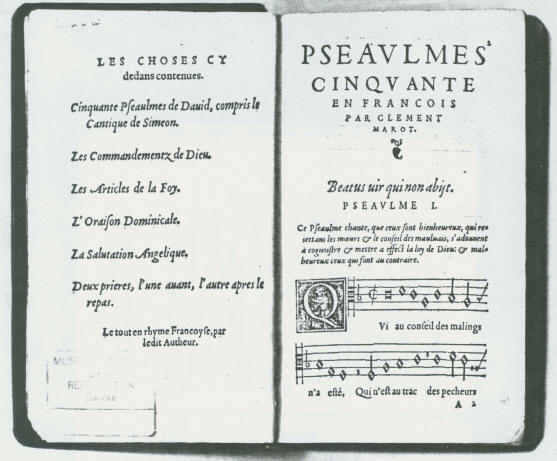
1549 - p. 44 - question, correction - Table pour trouver les pseaumes: The last psalm mentioned in this table (column 'Mercredy' - week 17): Psalm 64 must be an error, since Psalm 64 was not translated yet in 1549. I suppose it must be Psalm 46.
1549 - p. 46 - 49IV - correction - Pidoux's entry to introduce Susato's musical settings of the two prandial prayers, is incorrect. Le onzieme livre de chansons... composées par Maistre Pier de Manchicourt... semblable a 45/II should be replaced by the following entry: L'unziesme livre contenant 29 chansons amoureuses a quatre parties, propices a tous instrumentz, musicaulx, avec deux prières ou oraisons que se peuvent chanter devant et apres le repas (Antwerp: Tielman Susato, 1549) RISM 154929. [HS]. more info
- f° 2r° « Priere devant le repas. O souverain pasteur et maistre » (Tielman Susato) - first entry of this chansonnier
- f° 16v° « Priere apres le repas. Pere eternel qui nous ordonne » (Tielman Susato) - last entry of this chansonnier
1550 - p. 48 - Le droict chemin: The Marot psalms quoted (without melody) are Ps. 104 and Ps. 9.
1551 is an important year in the publication of the Psalters with tunes. Pidoux only new these events partially. So it seems appropriate to elaborate a little on the main events.
1. Théodore de Bèze publishes his first 34 versifications. And the (music) punch cutter Pierre Haultin arrives in Geneva. He is responsible for the first top of the notch Psalter with tunes, printed in Geneva (see below: GE51).
2. Around the same time another new versifications had appeared outside Geneva: Gilles d'Aurigny and Poictevin. Commercial but also ideological competition for the 'completion of the Psalter of Marot'.
3. 1551 is also the year in which Paris had its first Marot-Psalters, published with the common (Geneva) tunes. They were prepared by a Strasbourg printer (Rémy Guédon, see also ST48) and published with the aid of Claude Garamond. Descriptions of these Paris Psalters from the early 1550s are absent in Pidoux, because these editions were - then - not known. Pidoux however knew a very late reprint of this edition: 1561. A full descripton on p. 124 (61/I). Here only a short description of these first Paris Psalter:
PA51
PSEAVMES DE / DAVID TRADVICTZ SELON / L’HEBREV PAR CLE-/MENT MAROT. /
[ornement] /
Auec l’artifice rethoricque, & tables
/
des obseruations d’iceulx, non enco-/res
par cy deuant Imprimez.
/ [ornement] / [ornement] On les vend, / à Paris par Claude garramond, /
demourãt à la rue des Carmes, / à L’enseigne de la Boulle. / 1551.
Next to all Marot Psalms a number of prayers and (old) hymns in French is
included. This edition is printed again - or is it a twin edition? - in 1552, using the
same material (the printing device of Guédon at the end carries as date 1551). Also a copy (ca. 1554) is known, and the 1561
republication, described by Pidoux (61/I). All use the samen
woodcut-engravings of the Psalm and hymn tunes. This Psalter also served as basis for
Nicholas Du Chemin to publish his Psalter-with-tunes in 1556. Pidoux (56/I)
1551, p. 53 - major addition - [GE51] 51/II; In 1962 Pidoux had to rely on the description of a lost copy. In 1966 a copy was discovered acquired in the USA, which was identified and published in facsimile in 1973. The most interesting part is the 'Advertissement' (preface) by Bourgeois, in which he explains what he did with the melodies of the previous Psalters, why he changed some of them and which ones were inspired by older church melodies (hymns). Here a short description, enough for quotation. A complete description with texts on a separate webpage including the Advertissement.
PSEAUMES // OCTANTETROIS DE // David, mis en rime francoise. A savoir, qua- // ranteneuf par Clement Marot, avec le Canti- // que de Simeon & les dix Commandemens. // Et trentequatre par Theodore de Besze, de // Vezelay en Bourgongne.
[printer's mark]
Avec privilege pour les Pseaumes dudict Besze // A GENEVE. // De l’imprimerie de Jean Crespin // M. D. LI.
copy since 1966 at Rutgers University Library / New Brunswick, New Jersey (facsimile 1973)
Contenu :
- CALVIN - epistre au Lecteur : A tous chretiens (42/II) : 10/6/43
- BEZE - A l’Eglise de nostre Seigneur : Petit Troupeau (53/IC)
- PSEAUMES QUARANTENEUF traduits par Clement Marot. // ET TRENTEQUATRE par Theodore de Besze
83 psalms… (description and identification, see GE54)
after ps. 143 : Fin des Pseaumes mis en rime
- Le Cantique de Simeon LUC II Nunc dimittis servum tuum CL. MA. (tune 202f)
- Les Commandemens de Dieu EXODE XX. Audi Israel CL. MA. (tune 201d)- FIN
pagenumbers stop (p. 288)
V i. Priere devant le repas (with melody / t Marot) 203b
-- Priere apres le repas (with melody / t Marot) 204b
V ii. Les articles de la Foy (without melody / t Marot)
-- L’oraison de Nostre Seigneur Iesus Christ MATTH VI. Pater noster qui es in caelis CL.MA. (without melody)
V. iii. Advertissement touchant les chants de Pseaumes Louis Bourgeois (r/v).
folionumbers stop
[V vi] Autre TABLE des Pseaumes : tant de ceux de Cl. Marot, que de Th. de Besze.
(alfabetical) until V. 7v]
[V viii.] Epitaphe de Clement Marot etc..
FULL DESCRIPTION HERE
1552, p. 57 -52/III - correction - should be 56/VI (et non pas 56/IX ) [MH]. Indeed: One should look for Psalm settings of Cauléry in that edition (Le Jardin Muscial II, 1556). AND: Jean Cauléry did not compose a setting of psalm 33 (Resveillez vous chacun fidèle), but of a chanson with the incipit "Esveillez vous, car pour l'heure il est temps" (= in 52/III)
1552 - important addition -
Premier livre de psalmes et cantiques en
vulgaire francoys, composez en musique par divers autheurs, en quatre volumes.
(Paris: Fezandat) [Tenor in BNF; Contratenor of the 1556 reprint in Liceo
Musicale in Bologna]. - 4 v. (30 p.). Contains works by A. Gardane, Legendre, J.
Maillard, Mithou, Mittantier, C. de Sermisy, V. Sohier.
Full description of the contents at Pidoux 56/IV, (p. 99-100). Most texts
by G. Gueroult and music by Legendre. But also: Marot's 'Père de nous'
(Mittantier), 'Resjouy toy Vierge' (Val. Sohier), Prandial prayers 'O Souverain
Pasteur', 'Pere eternel' (Legendre).
1553 - important addition -
Second livre de psalmes et cantiques spirituels
en vulgaire
francoys, composez en musique par divers autheurs, en quatre volumes.
(Paris: Fezandat) [Liceo Musicale Bologna]. Contains works by Legendre, J.
Maillard, Manchicourt, C. de Sermisy, V. Sohier, Certon, Charles.
Full description of the contents, see Pidoux 1556, (56/V) p. 100. This
time only texts by Marot: 'Père de nous' (Claudin), Ps. 3 (Certon (!) - Pidoux
does not mention a link to the Geneva melody), Ps. 137 (Charles), Ps. 15
(Maillard), Ps. 130 (Manchicourt - reprint of 45/II), Ps. 114 (Legendre),
Decalogue (Legendre).
1554, p. 67 first entry: 'Guillaume de Boys.. Pidoux remarks: 'Est-ce le "premier livre" dont 55?II serait le second. The answer is 'yes'... See the addition below. A partial copy of the tenor partbook has been found.
1554, p.73, - correction - dernière ligne: remplace minime par semi-brève. (Pidoux, erratum)
1554/IV, p. 75. -Références inexactes des deux premiers cantiques; il faut lire 209d (au lieu de 209C) et 208d (au lieu de 208C). Les prières devant et après le repas « O Souverain pasteur et maistre », « Père eternel qui nous ordonnes » ainsi que la dernière pièce du recueil « Si quelque injure l'on vous dit » figurent dans ce même ouvrage avec la musique du ténor de Legendre telle qu'elle est contenue dans le Premier livre de psalmes et cantiques en vulgaire francoys ... Paris, Fezandat, 1552 (RISM 15523).[MH]
1554
- important addition
-
unknown until 2011: Premier livre des pseaumes et
sentences... Mis en musique en forme de motetz par
divers excellens musiciens [Genève,] Simon Du Bosc et Guillaume Guéroult,
1554. o.a. Gentian (ps. 6 =
original text!), Willaert (ps. 3) .
The content (as published by Jean
Duchamp in Revue de Musicologie
97, 2011/2, p. 413:). NB 'Vuillard' =
Willaert.
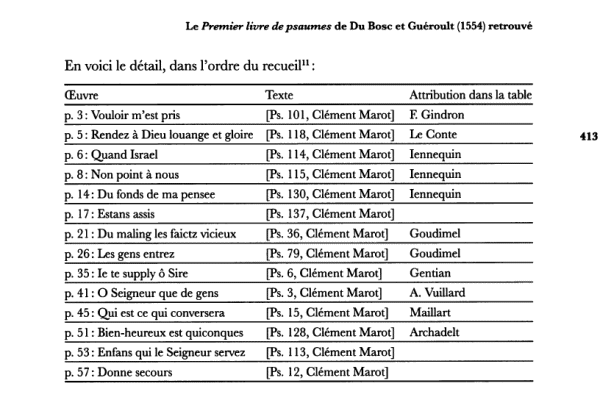
Unfortunately only the Tenor Partbook has been found
(in a convolute), and incomplete.
For Gentian (ps. 6), Willaert (ps. 3)and Arcadelt (ps. 128)it is interesting to compare the bassus of a Paris 'recueil', discovered in Geneva 2012. See below 1565 . Tenor and Bass present, only Altus and Superius have to be reconstructed. <jumpto>
1555 -
addition - Jardin musical,
contenant plusieurs belles fleurs de Chansons a trois parties ... ensemble le
blason de beau & laid tetin... premier livre
(Anvers: H. Waelrant et J. Laet [1555]) RISM [1555]22.
Two Marot psalms by Hubert Waelrant. [MH/HS]. No connection with the Huguenot
melodies:
« Ne veuille pas o Sire » (ps. 6)
« Rendez a Dieu louange et gloire » (ps. 118)
1556, p.99-100 - correction - The entries 56/IV and 56/V (Premier et second livre de Psalmes et cantiques...(div. autheurs, imp. Michel Fezandat) were already printed in 1552 and 1553 respectively (Pidoux, erratum). See above
1556, p.101 -
correction -
The enumeration of the Psalms/Prayers is
correct:
- in
Jardin Musical II (Waelrant: Pss 7, 12, 103 , 113 & Cauléry: Ps. 13,
Lord's Prayer, Angelic Greeting, Canticle of Simeon): 56/VI A
- Jardin Musical
III (Waelrant, Clemens non Papa): 56 VI/ B
The Notabene
in small font that concludes the entry 56/VI "Le livre premier... ne
comprend que des chansons profanes" should be
deleted. See above.
|
two pages from
Jardin Musical
II:
title and index |
|
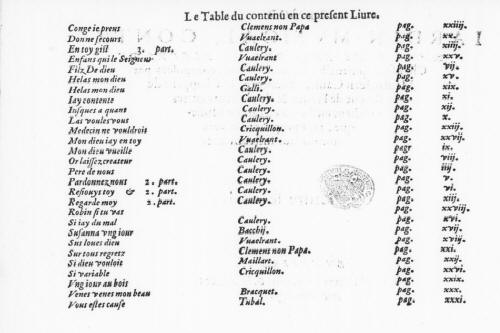 |
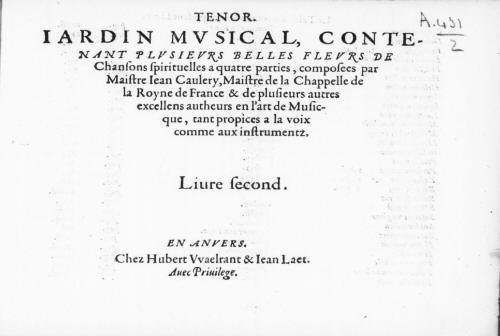 |
1557, p.105 - correction - ligne 4, lire: Chavannes, Extraits, p. 144. (Pidoux, erratum)
1559 - avril (Dans le volume de documents l'auteur a inséré beaucoup de textes, dont parfois des chroniques sur le chant des psaumes dans les provinces françaises). Une telle publication, si elle pouvait être exhaustive, permettrait de dresser une sorte de carte de la diffusion du Psautier. On ajoutera ici un texte supplémentaire qui concerne Bourges :
Depuis le commencement d'avril 1559 et tout l'été suivant, « on chantoit à grandes troupes tous les soirs tant festes que jours ouvriers, les Psalmes de David, on lieu qu'on appelle le Pretz Fichault et se assembloient audict lieu, tous les soirs, du monde innumérable tant hommes que femmes, chantant en grande mellodie lesdictz psalmes. Plusieurs deffences furent faictes par criz public, de non plus chanter lesdictz psalmes sur peine de la hard, et fut élevé une potence on millieu dudict pretz Fichault... Toutesfoys nonobstant toutes les choses susdictes, on ne cessa point de chanter ondict lieu, tout durant l'esté» (Journal de Jehan Glaumeau, Bourges 1541-1562, éd. Hiver, 1867). [FS]
1556/IV, pp. 99, 100. -L'ouvrage ici décrit a le même contenu qu'une première édition parue en 1552 (RISM 15523) à l'exception de «O Roy des Roys immortel, invisible » de M. Blanchier qui remplace la chanson sur le même texte de Claudin [de Sermisy]. La table continue cependant à attribuer la pièce à Claudin alors que la musique donne le nom de M. Blanchier. Dans le dépouillement de cet ouvrage le texte littéraire des chansons « Si quelque injure l'on vous dit », « Le fruict de vie» et « O Roy des Roys » est attribué sans raison valable à Guillaume Guéroult. [MH]
1559/VII, p. 116. -Le psaume de Cl. le Maistre est le psaume 42 (et non le ps. 34). musique de Philibert Jambe de Fer (242). Il faut également rectifier en bas de page: «voyez notre mélodie 242 » (au lieu de 237). [MH] The remark about Douen is correct, since it concerns ps. 42 from the Psautier de Lyon (text: Cl. Lemaistre). All four voices now being available, here is the reconstituted psalm 42
1560. - A cette date devrait figurer la mention du ms. Grolier, voir Lesure et Thibault, Bibliographie Le Roy et Ballard, n° 68bis. [MH]
1561/V, p. 126. -Le texte du psaume «Comme le cerf longuement pourchassé» est de Cl. le Maistre (et non de Poitevin). La musique est de Ph. Jambe de Fer. Voir 1559/VII. [MH]
1562. p. 131, - addition and correction - P. P. reproduit les noms des contractants de 1562 pour l'édition collective et « charitable » du psautier publié « pour Antoine Vincent ». Il parait sage de corriger la lecture de Robert « Bréart », nom inconnu de la librairie parisienne de ce temps, par Robert « Ballart », comme nous l'avons proposé dans la bibliographie Le Roy-Ballard. [FS]. Innumerable publications on this topic have seen the light since, esp. by G. Morisse and J.M Noailly. A new synthesis by Gérad Morisse, 'le Psautier de 1562', in the bulletin Psaume (n°5, 1991), 106-128.
1564. -A cette date devrait figurer Le Cantique des Cantiques de Salomon ... par Pierre de Courcelles ... ensemble, Les Lamentations de Jeremie le Prophete, avec l'Epistre d'iceluy. Paris, Robert Estienne, 1564 – Paris, Bibl. Nat., Rés. A 6922; Bibl. de l'Arsenal, Th. 1270, in-16, rés.[MH]
1565 - addition - (ca. 1565) a manuscript collection including Psalms, a.o. by Willaert (ps. 3), Gentian (ps. 6), Arcadelt (ps. 128): Genève BGE Ms. Mus. 572. 'Un recueil parisien de psaumes, de chansons spirituelles et de motets' (article by Laurent Guillo and Jean-Michel Noailly, Pierre Pidoux) Full description online: https://hal.archives-ouvertes.fr/hal-01216880
1598 - addition - Dodecacorde contenant douze Pseaumes de David, mis en musique selon les douze modes, approuvez des meilleurs autheurs anciens & modernes. A 2. 3. 4. 5. 6. & 7. voix. Par Claud. Le Jeune... A La Rochelle, par Hierosme Haultin, M.D.XCVIII., [1598]. Modern edition in RRMR, lxxiv–lxxvi (1989)
This site was last updated Friday, 26 January 2024







